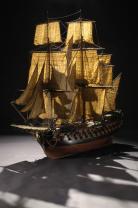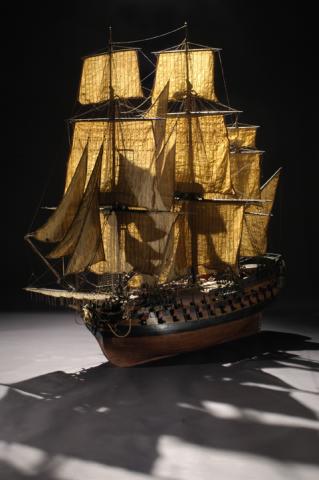The "Conquérant"
The Conquérant, the third of the name, was a remarkable three-master famous for her longevity: 58 years of good and loyal service, compared to two or at most three decades for her peers. She was also involved in all of the great battles of the second half of the 18th century.
Launched in Toulon in 1746, the Conquérant joined the Ponant fleet in Brest in the following year. Nearly 30 years later, she travelled to Bordeaux, where she remained for three years. Bordeaux's Port de la Lune was not a military port, but during periods of conflict, warships were assigned to protect maritime trade.
The Conquérant's true wartime adventure began after her stay in Bordeaux. In 1778, King Louis XVI of France decided to support the American side in the American Revolutionary War. The Conquérant first took part in the victorious Battle of Ushant, which marked the renaissance of the French Navy. In 1780 the ship was part a squadron of nine vessels supporting Lafayette on the American coast. She performed bravely in several battles in Bermuda, in Chesapeake bay and the Caribbean, where she experienced both glory and defeat. In 1782 she escorted a major fleet carrying colonial products returning to the Old World and called at Toulon for extensive repairs. She remained there during the revolutionary period before being hastily rearmed in 1798 as part of Napoleon Bonaparte's "Egyptian expedition" for which he embarked 40,000 men on 280 vessels. Unwisely moored with twelve other vessels, four frigates, three galiots and two brigs for revictualling in the bay of Aboukir, she was surprised by Nelson's fleet, and the ensuing Battle of the Nile was a major disaster for the French: 1700 French dead, 3000 prisoners and innumerable injured compared to 218 dead on the English side. Escorted by her captors, she set off to England where she ended her life as a hulk (floating prison).
According to the naval architecture specialist Jean Boudriot, the Conquérant was a perfect example of 18th naval expertise; a ship of the line with 74 cannon divided on two decks (two batteries of cannons one above the other) which could transport 650 men. The name "ship of the line" comes from the way in which these vessels manoeuvred in lines during battle. As a general rule, the first two ranks of the line were three-decker vessels (usually with 120 cannon), followed by three ranks of two-deckers and finally a rank of single-deck ships. The confrontation took place in parallel lines, and the main tactic consisted of cutting the enemy's line to isolate his ships. This organisation developed over time and during the 18th century, three-decker ships gave way to two-decker "74s" (so-called due to their 74 cannon) of which the Conquérant was an advanced example.
The Conquérant was an impressive vessel, and the 1/36th scale model is equally so: 1.63 m long, 1.05 m wide and 1.75 m high, with all of her sails spread, enabling the visitor to examine all of the details of the model's construction and decoration. Maritime models were frequently produced by master carpenters prior to the construction of the vessel in order to present it to the sponsors of the ship, who were often unfamiliar with the reading of technical plans. However, this model was built later than the ship itself, probably in around 1770, and was somewhat simplified, having only 64 cannons. This model, together with several others, belonged to a maritime engineer who donated them to the town of Bordeaux in 1911, enabling the creation of the town's first naval museum within the Carreire Museum with its collections of weapons and ancient objects.

